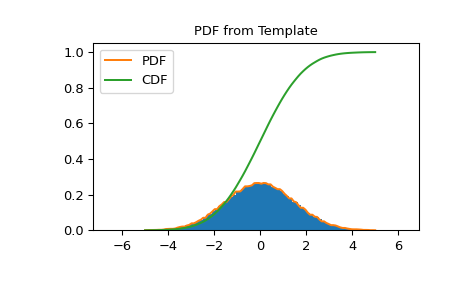rv_histogram#
- class scipy.stats.rv_histogram(histogram, *args, density=None, **kwargs)[source]#
Generates a distribution given by a histogram. This is useful to generate a template distribution from a binned datasample.
As a subclass of the
rv_continuousclass,rv_histograminherits from it a collection of generic methods (seerv_continuousfor the full list), and implements them based on the properties of the provided binned datasample.- Parameters:
- histogramtuple of array_like
Tuple containing two array_like objects. The first containing the content of n bins, the second containing the (n+1) bin boundaries. In particular, the return value of
numpy.histogramis accepted.- densitybool, optional
If False, assumes the histogram is proportional to counts per bin; otherwise, assumes it is proportional to a density. For constant bin widths, these are equivalent, but the distinction is important when bin widths vary (see Notes). If None (default), sets
density=Truefor backwards compatibility, but warns if the bin widths are variable. Set density explicitly to silence the warning.Added in version 1.10.0.
- Attributes:
random_stateGet or set the generator object for generating random variates.
Methods
__call__(*args, **kwds)Freeze the distribution for the given arguments.
cdf(x, *args, **kwds)Cumulative distribution function of the given RV.
entropy(*args, **kwds)Differential entropy of the RV.
expect([func, args, loc, scale, lb, ub, ...])Calculate expected value of a function with respect to the distribution by numerical integration.
fit(data, *args, **kwds)Return estimates of shape (if applicable), location, and scale parameters from data.
fit_loc_scale(data, *args)Estimate loc and scale parameters from data using 1st and 2nd moments.
freeze(*args, **kwds)Freeze the distribution for the given arguments.
interval(confidence, *args, **kwds)Confidence interval with equal areas around the median.
isf(q, *args, **kwds)Inverse survival function (inverse of
sf) at q of the given RV.logcdf(x, *args, **kwds)Log of the cumulative distribution function at x of the given RV.
logpdf(x, *args, **kwds)Log of the probability density function at x of the given RV.
logsf(x, *args, **kwds)Log of the survival function of the given RV.
mean(*args, **kwds)Mean of the distribution.
median(*args, **kwds)Median of the distribution.
moment(order, *args, **kwds)non-central moment of distribution of specified order.
nnlf(theta, x)Negative loglikelihood function.
pdf(x, *args, **kwds)Probability density function at x of the given RV.
ppf(q, *args, **kwds)Percent point function (inverse of
cdf) at q of the given RV.rvs(*args, **kwds)Random variates of given type.
sf(x, *args, **kwds)Survival function (1 -
cdf) at x of the given RV.stats(*args, **kwds)Some statistics of the given RV.
std(*args, **kwds)Standard deviation of the distribution.
support(*args, **kwargs)Support of the distribution.
var(*args, **kwds)Variance of the distribution.
Notes
When a histogram has unequal bin widths, there is a distinction between histograms that are proportional to counts per bin and histograms that are proportional to probability density over a bin. If
numpy.histogramis called with its defaultdensity=False, the resulting histogram is the number of counts per bin, sodensity=Falseshould be passed torv_histogram. Ifnumpy.histogramis called withdensity=True, the resulting histogram is in terms of probability density, sodensity=Trueshould be passed torv_histogram. To avoid warnings, always passdensityexplicitly when the input histogram has unequal bin widths.There are no additional shape parameters except for the loc and scale. The pdf is defined as a stepwise function from the provided histogram. The cdf is a linear interpolation of the pdf.
Added in version 0.19.0.
Examples
Create a scipy.stats distribution from a numpy histogram
>>> import scipy.stats >>> import numpy as np >>> data = scipy.stats.norm.rvs(size=100000, loc=0, scale=1.5, ... random_state=123) >>> hist = np.histogram(data, bins=100) >>> hist_dist = scipy.stats.rv_histogram(hist, density=False)
Behaves like an ordinary scipy rv_continuous distribution
>>> hist_dist.pdf(1.0) 0.20538577847618705 >>> hist_dist.cdf(2.0) 0.90818568543056499
PDF is zero above (below) the highest (lowest) bin of the histogram, defined by the max (min) of the original dataset
>>> hist_dist.pdf(np.max(data)) 0.0 >>> hist_dist.cdf(np.max(data)) 1.0 >>> hist_dist.pdf(np.min(data)) 7.7591907244498314e-05 >>> hist_dist.cdf(np.min(data)) 0.0
PDF and CDF follow the histogram
>>> import matplotlib.pyplot as plt >>> X = np.linspace(-5.0, 5.0, 100) >>> fig, ax = plt.subplots() >>> ax.set_title("PDF from Template") >>> ax.hist(data, density=True, bins=100) >>> ax.plot(X, hist_dist.pdf(X), label='PDF') >>> ax.plot(X, hist_dist.cdf(X), label='CDF') >>> ax.legend() >>> fig.show()
